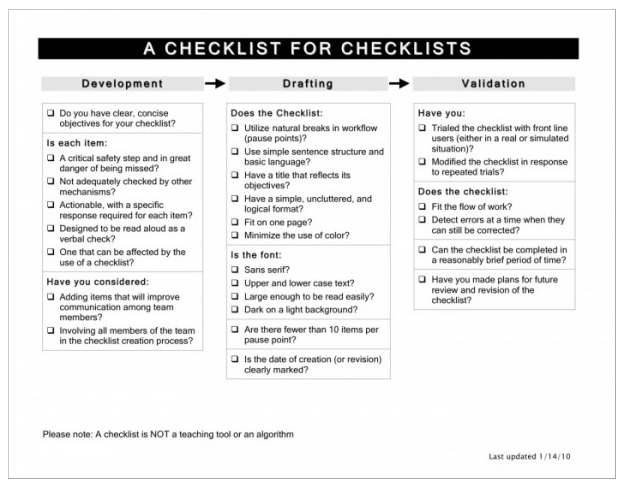Changing how you and your team work is hard. Especially at the start, it feels like one more thing that you have to do on top of all your regular work. When we coach teams, we help them break down overwhelming projects into little tasks that can be accomplished in two days, two weeks, and two months. But what happens when you want to create a new habit, not just complete a one-time project? Luckily, it’s not rocket surgery: identify a few practices you want to adopt, create a simple checklist for each, and then use that checklist every time.
We learned this idea from Dr. Atul Gawande, who discovered that using a checklist before surgery increased patients’ survival rates by 47%. His practice was inspired by the US Air Force, which adopted checklists in order for pilots to manage increasingly complicated cockpits. Fortunately, your day-to-day job probably doesn’t operate under life-or-death situations, but using a checklist can free up much-needed brainspace: when you don’t have to focus on how (of if) something gets done, you can focus more on the problem itself.
If you want to start putting together a checklist for a new practice at your work, keep in mind the following:
- Think about the criteria for the checklist. What are the signs that you should pull out your checklist? It could time-based (every Monday morning), based on a requestor, (the CEO needs a report), budget-based (when you spend over a set amount), or a combination of other factors.
- Make it actionable. As you’re building the checklist, focus on activities that are critical for a positive outcome, and that require a defined response. Don’t forget that this can include activities that will increase communication between team members.
- Identify who will read the checklist. Assign someone to read off (and check) the checklist every time it’s used, and make sure they have the authority to keep the team accountable.
- Test and refine the list. You probably won’t think of everything the first time, so keep testing and refining the checklist to make it more powerful.
Still need help creating a checklist? Check out this checklist for checklists:














